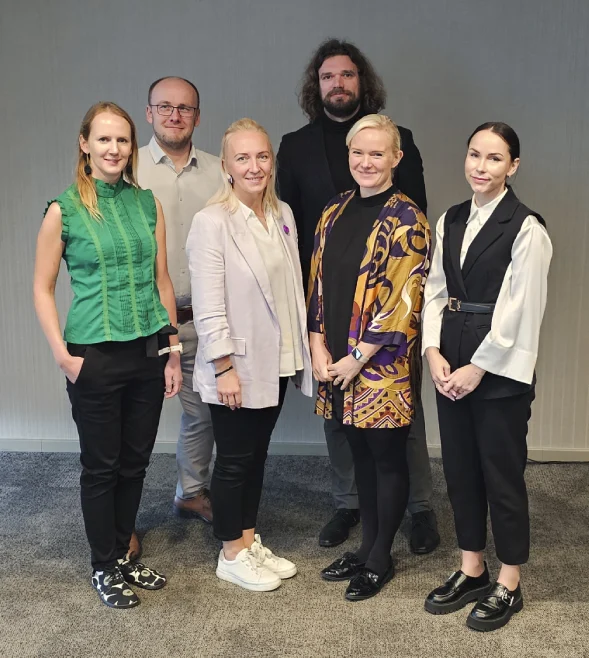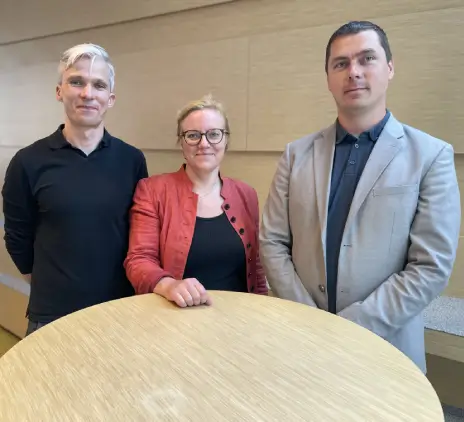-
Other audit services
We help clients with the application and use of foreign financial aid of EU and other funds and help prepare financial reports.
-
Audit calculator
The calculator will answer if the company's sales revenue, assets or number of employees exceed the limit of an inspection or audit.
-
Payroll and related services
We perform payroll accounting for companies whether they employ a few or hundreds of employees.
-
Tax accounting
Grant Thornton Baltic's experienced tax specialists support accountants and offer reasonable and practical solutions.
-
Reporting
We prepare annual reports in a timely manner. We help to prepare management reports and various mandatory reports.
-
Consolidation of financial statements
Our experienced accountants and advisors help you prepare consolidation tables and make the consolidation process more efficient.
-
Consultancy and temporary staff
Our experienced specialists advise on more complex accounting transactions, rectify poor historic accounting, and offer the temporary replacement of an accountant.
-
Outsourced CFO service
Our CFO service is suitable for companies of all sizes and in all industries. We offer services to our clients in the required amount and competences.
-
Assessment of accounting processes
We help companies to implement accounting practices that are in compliance with local and international standards.
-
Accounting services for small businesses
We offer affordable service for small businesses. We help organize processes as smartly and cost-effectively as possible.
-
Cryptocurrency accounting
We keep up with blockchain technology to serve and advise crypto companies. We are supported by a network of colleagues in 130 countries.
-
Trainings and seminars
Our accountants have experience in all matters related to accounting and reporting. We offer our clients professional training according to their needs.

-
Business advisory
We offer legal support to both start-ups and expanding companies, making sure that all legal steps are well thought out in detail.
-
Fintech advisory
Our specialists advise payment institutions, virtual currency service providers and financial institutions.
-
Corporate advisory
We advise on legal, tax and financial matters necessary for better management of the company's legal or organizational structure.
-
Transaction advisory
We provide advice in all aspects of the transaction process.
-
Legal due diligence
We thoroughly analyze the internal documents, legal relations, and business compliance of the company to be merged or acquired.
-
In-house lawyer service
The service is intended for entrepreneurs who are looking for a reliable partner to solve the company's day-to-day legal issues.
-
The contact person service
We offer a contact person service to Estonian companies with a board located abroad.
-
Training
We organize both public trainings and tailor made trainings ordered by clients on current legal and tax issues.
-
Whistleblower channel
At Grant Thornton Baltic, we believe that a well-designed and effective reporting channel is an efficient way of achieving trustworthiness.

-
Business model or strategy renewal
In order to be successful, every company, regardless of the size of the organization, must have a clear strategy, ie know where the whole team is heading.
-
Marketing and brand strategy; creation and updating of the client management system
We support you in updating your marketing and brand strategy and customer management system, so that you can adapt in this time of rapid changes.
-
Coaching and development support
A good organizational culture is like a trump card for a company. We guide you how to collect trump cards!
-
Digital services
Today, the question is not whether to digitize, but how to do it. We help you develop and implement smart digital solutions.
-
Sales organisation development
Our mission is to improve our customers' business results by choosing the right focuses and providing a clear and systematic path to a solution.
-
Business plan development
A good business plan is a guide and management tool for an entrepreneur, a source of information for financial institutions and potential investors to make financial decisions.
-
Due diligence
We perform due diligence so that investors can get a thorough overview of the company before the planned purchase transaction.
-
Mergers and acquisitions
We provide advice in all aspects of the transaction process.
-
Valuation services
We estimate the company's market value, asset value and other asset groups based on internationally accepted methodology.
-
Forensic expert services
Our experienced, nationally recognized forensic experts provide assessments in the economic and financial field.
-
Business plans and financial forecasts
The lack of planning and control of cash resources is the reason often given for the failure of many businesses. We help you prepare proper forecasts to reduce business risks.
-
Outsourced CFO service
Our CFO service is suitable for companies of all sizes and in all industries. We offer services to our clients in the required amount and competences.
-
Reorganization
Our experienced reorganizers offer ways to overcome the company's economic difficulties and restore liquidity in order to manage sustainably in the future.
-
Restructuring and reorganisation
We offer individual complete solutions for reorganizing the structure of companies.
-
Corporate taxation
We advise on all matters related to corporate taxation.
-
Value added tax and other indirect taxes
We have extensive knowledge in the field of VAT, excise duties and customs, both on the national and international level.
-
International taxation
We advise on foreign tax systems and international tax regulations, including the requirements of cross-border reporting.
-
Transfer pricing
We help plan and document all aspects of a company's transfer pricing strategy.
-
Taxation of transactions
We plan the tax consequences of a company's acquisition, transfer, refinancing, restructuring, and listing of bonds or shares.
-
Taxation of employees in cross-border operations
An employee of an Estonian company abroad and an employee of a foreign company in Estonia - we advise on tax rules.
-
Tax risk audit
We perform a risk audit that helps diagnose and limit tax risks and optimize tax obligations.
-
Representing the client in Tax Board
We prevent tax problems and ensure smooth communication with the Tax and Customs Board.
-
Taxation of private individuals
We advise individuals on personal income taxation issues and, represent the client in communication with the Tax and Customs Board.
-
Pan-Baltic tax system comparison
Our tax specialists have prepared a comparison of the tax systems of the Baltic countries regarding the taxation of companies and individuals.
-
Recruitment services – personnel search
We help fill positions in your company with competent and dedicated employees who help realize the company's strategic goals.
-
Recruitment support services
Support services help to determine whether the candidates match the company's expectations. The most used support services are candidate testing and evaluation.
-
Implementation of human resource management processes
We either assume a full control of the launch of processes related to HR management, or we are a supportive advisory partner for the HR manager.
-
Audit of HR management processes
We map the HR management processes and provide an overview of how to assess the health of the organization from the HR management perspective.
-
HR Documentation and Operating Model Advisory Services work
We support companies in setting up HR documentation and operational processes with a necessary quality.
-
Employee Surveys
We help to carry out goal-oriented and high-quality employee surveys. We analyse the results, make reports, and draw conclusions.
-
HR Management outsourcing
We offer both temporary and permanent/long-term HR manager services to companies.

-
Internal audit
We assist you in performing the internal audit function, performing internal audits and advisory work, evaluating governance, and conducting training.
-
Internal Audit in the Financial Services Sector
We provide internal audit services to financial sector companies. We can support the creation of an internal audit function already when applying for a sectoral activity license.
-
Audit of projects
We conduct audits of projects that have received European Union funds, state aid, foreign aid, or other grants.
-
Prevention of money laundering
We help to prepare a money laundering risk assessment and efficient anti-money laundering procedures, conduct internal audits and training.
-
Risk assessment and risk management
We advise you on conducting a risk assessment and setting up a risk management system.
-
Custom tasks
At the request of the client, we perform audits, inspections and analyzes with a specific purpose and scope.
-
External Quality Assessment of the Internal Audit Activity
We conduct an external evaluation of the quality of the internal audit or provide independent assurance on the self-assessment.
-
Whistleblowing and reporting misconduct
We can help build the whistleblowing system, from implementation, internal repairs and staff training to the creation of a reporting channel and case management.
-
Sustainability advisory
We help solve issues related to the environment, social capital, employees, business model and good management practices.
-
Sustainability audit
Our auditors review and certify sustainability reports in accordance with international standards.
-
Sustainable finance
We help investors to analyze the environmental issues, social responsibility and good management practices of the company of interest.
-
Sustainable tax
Our international tax specialists define the concept of sustainable tax behavior and provide services related to sustainable tax behavior.
-
Digital strategy
We help assess the digital maturity of your organization, create a strategy that matches your needs and capabilities, and develop key metrics.
-
Intelligent automation
We aid you in determining your business’ needs and opportunities, as well as model the business processes to provide the best user experience and efficiency.
-
Business Intelligence
Our team of experienced business analysts will help you get a grip on your data by mapping and structuring all the data available.
-
Cybersecurity
A proactive cyber strategy delivers you peace of mind, allowing you to focus on realising your company’s growth potential.
-
Innovation as a Service
On average, one in four projects fails and one in two needs changes. We help manage the innovation of your company's digital solutions!


Where to start if your company doesn’t have a human resources director and HR policy, and on top of it, has a negative employer net promoter score? Grant Thornton Baltic’s HR director Marge Litvinova and recruiter Kätlin Treima share some valuable experience.
Grant Thornton Baltic started way back in 1992, but human resources and employee experience topics were first broached in 2017 when the first HR director was hired.
In 2015, the company faced a situation where the employee promoter index was negative, there was a lack of focused attention to human resources topics and it was getting harder to find suitable employees.
Challenges in 2015–2017
1. The company lacked a unified strategy, and the various sub-units were basically organizational silos.
2. The predominant focus lay on financial targets.
3. The managers in charge of personnel had derived their roles from previously serving as specialists within the company.
4. The company lacked a HR policy and HR director.
5. Negative employer promoter index (-19%).
6. The situation on the job market made it increasingly harder to find and retain the necessary specialists.
Setting down the goals
Grant Thornton seized the bull by the horns and laid down four goals in 2018:
1. First, to create a company-side working group consisting of people from different services. They would be tasked with launching the development of a value-based culture.
2. Setting the focus on employee experience: making employee experience front and centre in every phase in the employee life cycle and putting together an action plan reflecting this.
3. Increasing the employer promoter index score to at least 25%: changing the employer’s image both inside and outside the company and achieving growth in the employer promoter index score.
4. Improving management quality: supporting managers who were originally in specialist roles in the transitioning to leading people through development programme and workshops where they can share experiences.
To address the problem, a five-member company-wide People & Culture working group was formed, and tasked with working on the challenges: creating a better employee experience for people, creating a values-based culture, attaining a positive employer promoter index score. The goal of the working group was to put the focus on different topics throughout all phases in the employees’ life cycle.
As a result of what was achieved, topics related to shaping employee experience were no longer just the domain of the HR director but covered more broadly throughout the company.
Preparing the action plan and laying a foundation
To make the activity truly company-wide, management and partners were included and joint agreements were reached. To map problem areas, a 360-degree feedback survey was conducted among all managers, the employee engagement was studied and interviews were conducted with employees. An external consultant – a management trainer – was brought in for the next activities.
To design a long-term plan for developing the soft competencies of managers, a manager development programme was initiated, which consisted of three training courses:
- from specialist to manager;
- a video training session on communication skills;
- ABC for mentors and supervisors.
A culture of regularly providing feedback was enshrined and attention began to be paid to such aspects as how to talk to employees so that the conversations would generate some meaning. Feedback itself was two-way: up-down and down-up.
The company’s structure also changed: in the past, the department head dealt with all employees of the department, but now smaller teams were created within each department, consisting of a team leader and 5-8 employees. Career journeys for employees were also mapped.
Ready... go!
The first to be developed was the employer value offer, along with giving it a broader dimension and regularly updating it. The company’s needs also suggested additional benefits that could be offered as part of the compensation package:
- employee health;
- recognition for seniority (from 3rd year on);
- flexible policy on holiday and leave.
The employee’s value offer became a standard part of job offers sent to candidates.
Secondly, flexible and trust-based work arrangements were implemented at the company; based on principles such as seasonal nature of work and arrangements that factored it in (including part-time loads), work-life balance, remote work options, flexible holiday/leave, etc. It was found that employment relations based on trust were the underpinning for everything and that employees had to have the confidence to talk to their higher-ups.
Third, changes began to be made to managers’ mindset and value-based recruitment was implemented. The priority was now on whether something conformed to the values and the concept, importance and role of the recruiting manager were now laid down. After that, the recruitment process itself was tackled and improved with such features as a tour of the office and meetings with the team; recruitment itself became digital through the use of software (Recrur, TeamDash).
Existing employees were supposed to become ambassadors for the employer’s brand, and accordingly, a career website that genuinely reflected the essence of the company and its employees was started, including profile stories on individuals. Besides job postings and profile stories, the career page includes the scholarships that the company’s employees have received, how they have represented the company at various events, references to open doors day and work shadow opportunities. The employees appear with their faces and names on social media and wanted ads, they are ambassadors for their employer and help the company stay visible.
Results
1. The company’s employer promoter index score rose from -19% to +50%. It reached positive territory in year 3. In 2023, for the first time, the recommendation index was measured in each quarter and it remained high even in the heavy-workload high season – 64%.
2. Change in managerial quality: employee feedback regarding human resources management is positive. Whereas the responses in 2016 to this question were 2.70 on a five-point scale, in 2023, the figure was 4.3. Honesty and openness in dealings with employees is up from 3.46 to 4.34.
3. Number of employees and retention rate: the number of employees is up (FTE) by 70% (from 71 to 121), and their retention rate is up from 70% to 83%.
4. Corporate culture metric: 4.7 (out of 5). In 2016, it was 3.59, but now it is one of the highest performing parameters in the employee engagement survey.
Value added
- Two employees who left us in 2023 wanted to return after spending a couple months at a different employer. The reason: very strong differences in corporate culture. We re-hired both of them.
- Employees from competitors have come over to us, since word is out about the great culture.
- We have a very strong alumni community among former employees who recall their time with us fondly and take part regularly in alumni events:
- Our reputation on the job market is much better and we are able to find good candidates with less effort.
- Feedback from our new employees after their probationary period is excellent. They often say the reality is even better than they expected.
- Our company’s turnover and profit have doubled.
This case study was written for the Kickoff 2024 recruitment marketing awards event held in March.
If you have similar challenges and questions, please contact our specialists.







